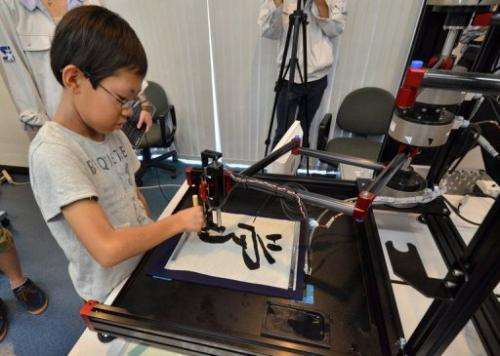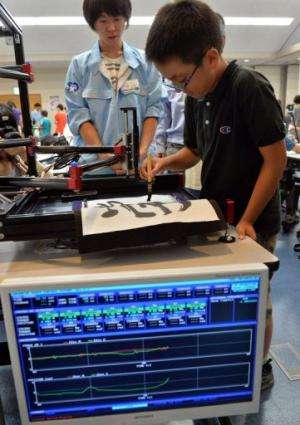Robot turning Japanese children into calligraphers

Nijiya Kurota's little hand grips a calligraphy brush dangling above a clean sheet of rice paper. The brush itself is being held dead straight, just as an expert who has spent years learning the art of "shodo"—Japanese calligraphy—would do.
That's because a robot arm is also attached to the brush and for a moment, as thick lines of glistening black ink are laid down on the page, Nijiya is transformed into a master calligrapher.
A few days ago the 10-year-old student and his classmates from a junior high school in Yokohama, close to Tokyo, came face to face with this strange invention.
Despite being a deft practitioner of such a subtle art form, there is nothing human about this collection of metal rods and whirring motors.
But the robot writes just like an expert calligrapher and its inventor hopes it will help teach a new generation of Japanese children an ancient skill that many fear is fast dying out.
"The teaching of calligraphy is all but lost so I thought I could forever preserve the art of our great masters on the robot's memory," explains Seiichiro Katsura, a professor at Keio University and the robot's inventor.
The machine itself consists of multiple engines and a mechanical arm which is attached to a brush. Its hard drive has been imbued with the skills of 90-year-old Juho Sado, a master calligrapher who taught the robot how to write a series of "Kanji" characters down to the most imperceptible of wrist movements and brush strokes.

The robot's complex sensors recorded everything, from the stroke order, the brush angle, the thickness of the line or the slightest pressure change. It then relays those memories to novices and gently corrects their hand movements if they go wrong.
The little school students from Yokohama were able to practice drawing kanji characters such as "study", "sea" and "flower" in classic cursive—a calligraphy style where all the lines are interconnected. Each time the students produce near perfect replicas.
"When you take the brush, it's as if the master himself is holding your hand and guiding you," said Ayaka Matsui, an assistant of Professor Katsura who teaches children how to use the robot during introductory workshops at the university.
Nijiya agrees. Proudly waving his "Gaku" character—which means "study"—he exclaims: "The master is not there but we feel his presence, like he's trying to teach us."
"It's great," adds his classmate Keisuke Yamagishi. "I only need to put a little bit of pressure through my arm and the brush glides across the paper."
Professor Katsura hopes this new technique will not only be able to teach people other forms of art, but also other fields such as surgery or mechanics.
"The process of transmitting knowledge by hand was often tedious, requiring a long process of acquiring techniques, intuition and experience," he says. "With this robot, the process becomes faster and more efficient."
© 2013 AFP




















